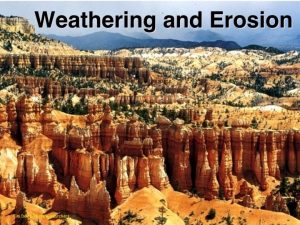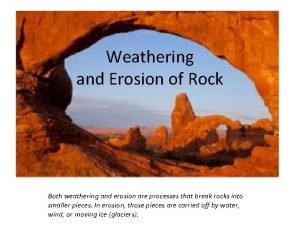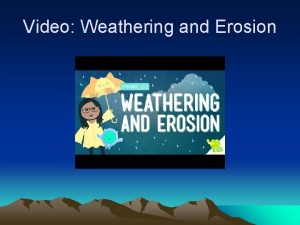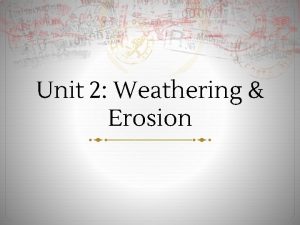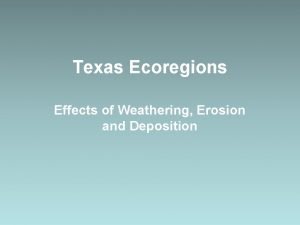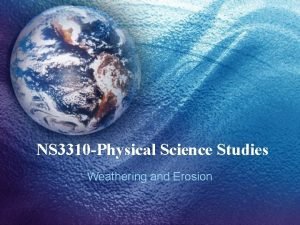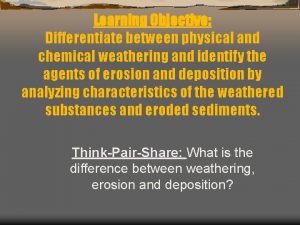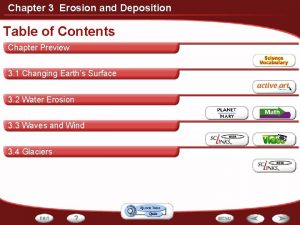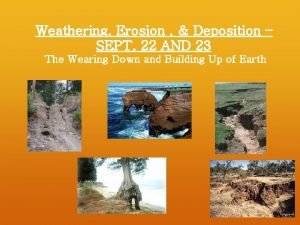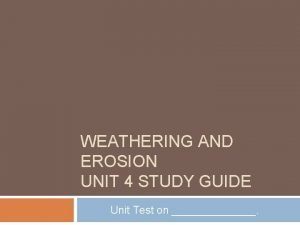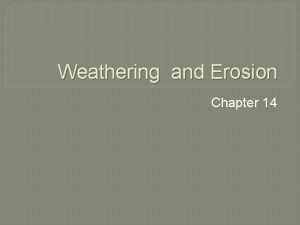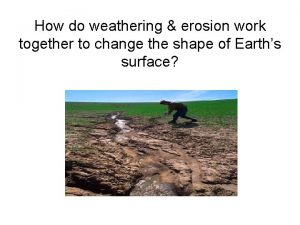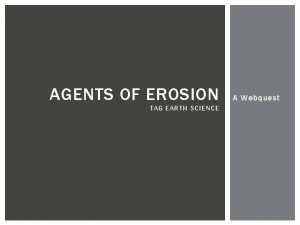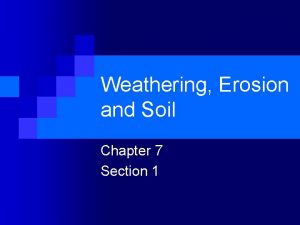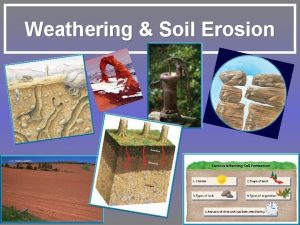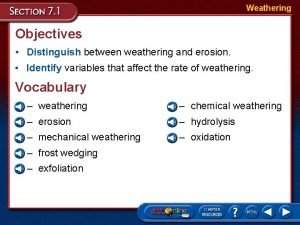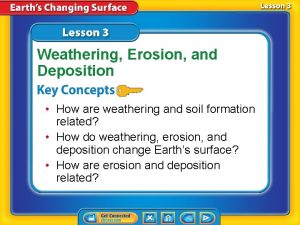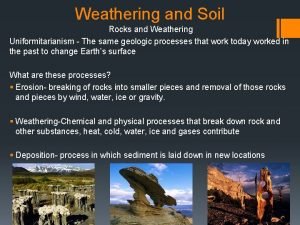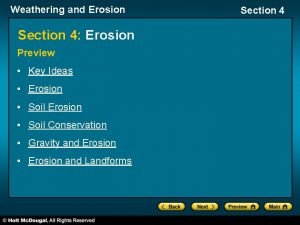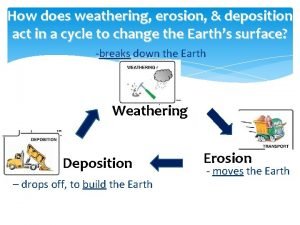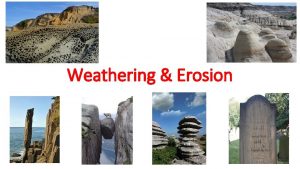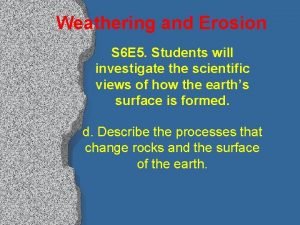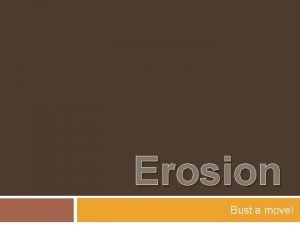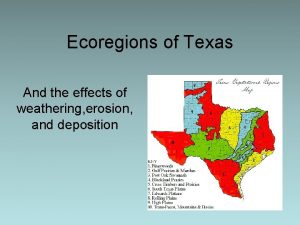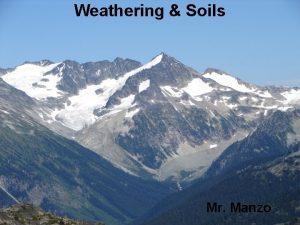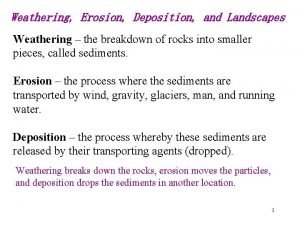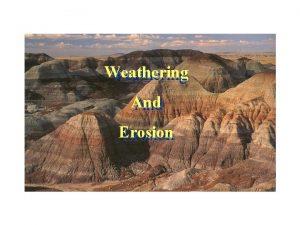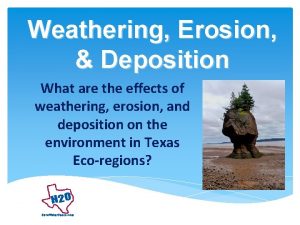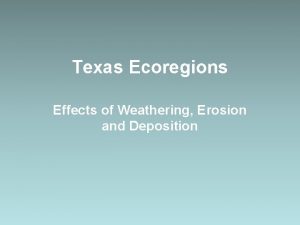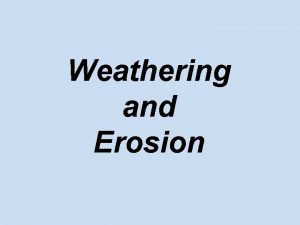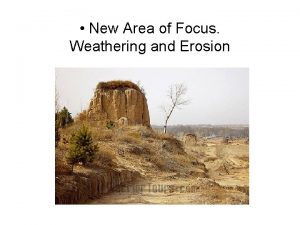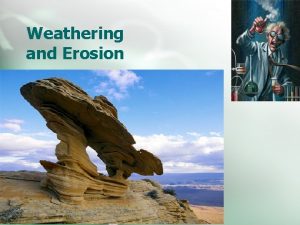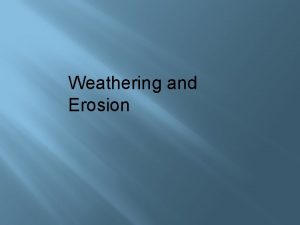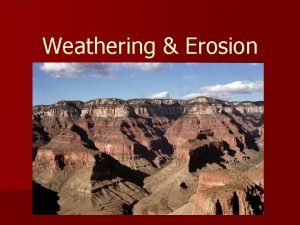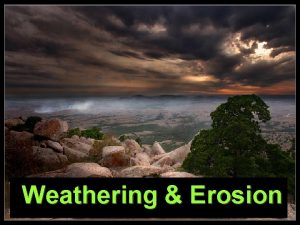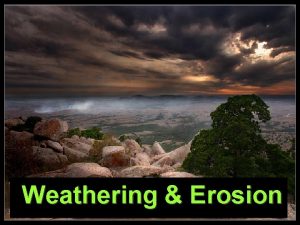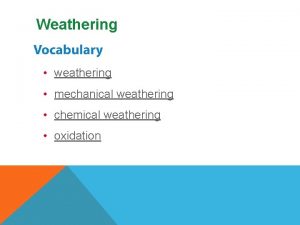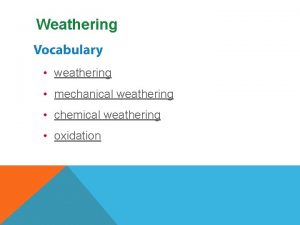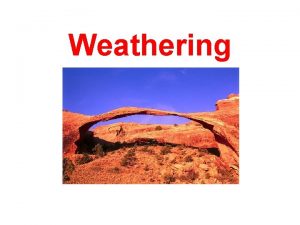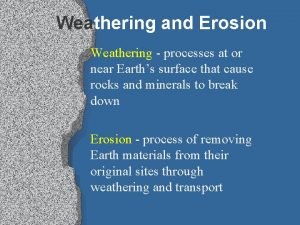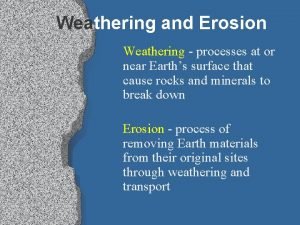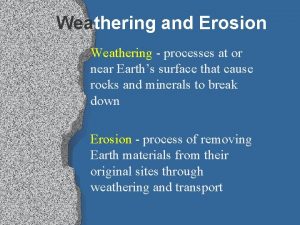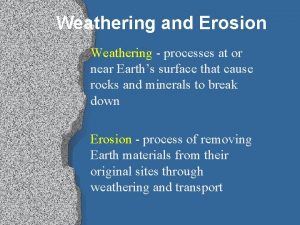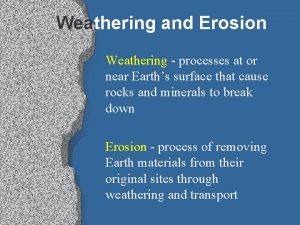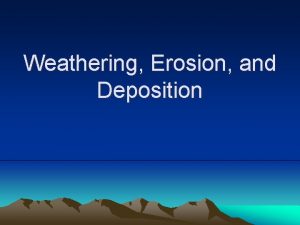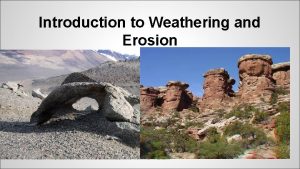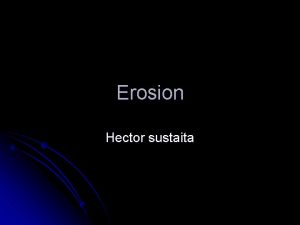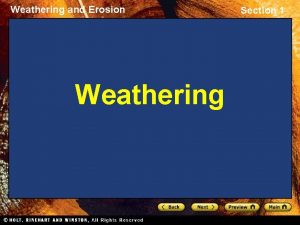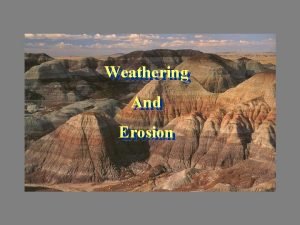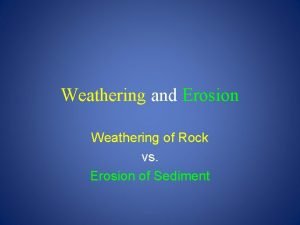Weathering and Erosion Weathering processes at or near





































- Slides: 37

Weathering and Erosion Weathering - processes at or near Earth’s surface that cause rocks and minerals to break down Erosion - process of removing Earth materials from their original sites through weathering and transport

Weathering Mechanical Weathering processes that break a rock or mineral into smaller pieces without altering its composition Chemical Weathering - processes that change the chemical composition of rocks and minerals

Processes and Agents of Mechanical Weathering These are actions or things that break down Earth materials l frost wedging l thermal expansion and contraction l mechanical exfoliation l abrasion by wind, water or gravity l plant growth

Processes and Agents of Mechanical Weathering l Frost Wedging – cracking of rock mass by the expansion of water as it freezes in crevices and cracks http: //www. uwsp. edu/geo/faculty/ozsvath/images/frost%20 wedging. jpg

Frost Wedging (in soil) Ice crystals

Processes and Agents of Mechanical Weathering l Thermal expansion and contraction – repeated heating and cooling of materials cause rigid substances to crack and separate http: //content. answers. com/main/content/wp/en-commons/thumb/d/dc/250 px-Weathering_freeze_thaw_action_iceland. jpg

Processes and Agents of Mechanical Weathering l Exfoliation – As underlying rock layers are exposed, there is less pressure on them and they expand. This causes the rigid layers to crack and sections to slide off (similar to peeling of outer skin layers after a sunburn). The expanding layers often form a dome.

Dome Exfoliation

Processes and Agents of Mechanical Weathering l Abrasion – Moving sediments or rock sections can break off pieces from a rock surface they strike. The sediments can be moved by wind or water and the large rock sections by gravity.

Wind Abrasion http: //www. uwsp. edu/geo/faculty/ritter/geog 101/textbook/images/lithosphere/eolian/rock_wind_abrasion_p 0772932441_NRCS. jpg

Wind and Water Abrasion http: //www. gsi. ie/Education/European+Landscapes/United+Kingdom. htm Photo Ref: P 211442, "IPR/52 -34 CW BGS©NERC

Processes and Agents of Mechanical Weathering l Plant Growth – As plants such as trees send out root systems, the fine roots find their way into cracks in the rocks. As the roots increase in size, they force the rock sections apart, increasing the separation and weathering.

Plant Wedging

Plant Wedging

Processes of Chemical Weathering l l l dissolving (dissolution) oxidation hydrolysis

Processes of Chemical Weathering Dissolving (dissolution) Water, often containing acid from dissolved carbon dioxide, will dissolve minerals from a rock body leaving cavities in the rock. These cavities may generate sinkholes or cave features such as stalactites and stalagmites.

Limestone cave feature result of dissolution

Processes of Chemical Weathering Oxidation Minerals may combine with oxygen to form new minerals that are not as hard. For example, the iron-containing mineral pyrite forms a rusty-colored mineral called limonite.

Pyrite Oxidation http: //www. windows. ucar. edu/earth/geology/images/pyrite_sm. jpg Pyrite http: //www. dkimages. com/discover/previews/965/75014124. JPG Limonite

Processes of Chemical Weathering Hydrolysis Minerals may chemically combine with water to form new minerals. Again these are generally not as hard as the original material.

Feldspar Hydrolysis http: //www. mii. org/Minerals/Minpics 1/Plagioclase%20 feldspar. jpg Feldspar http: //www. uwm. edu/Course/422 -100/Mineral_Rocks/kaolinite 1. jpg Kaolinite (clay)

Factors in Chemical Weathering l l Climate – wet and warm maximizes chemical reactions Plants and animals – living organisms secrete substances that react with rock Time – longer contact means greater change Mineral composition – some minerals are more susceptible to change than others

Weathering and Erosion Weathering produces regolith (“rock blanket”) which is composed of small rock and mineral fragments. When organic matter is mixed into this material it is called soil.

Erosion Transport Agents or Forces l l l Water rain streams and rivers ocean dynamics ice in glaciers Wind Gravity

Streams Flowing water will lift and carry small sediments such as silt and sand.

Stream Erosion and Deposition Where water moves more swiftly there will be more erosion. Where the water slows down, sediments will be deposited.

Ocean Dynamics l Tidal action and waves carry away weathered materials. http: //edge. tamu. edu/waves 2001/PC_tour/erosion_files/image 002. jpg http: //www. dkimages. com/discover/previews/1000/50195183. JPG

Glaciers are large ice fields that slowly flow downhill over time. http: //images. encarta. msn. com/xrefmedia/sharemed/targets/images/pho/t 628/T 628797 A. jpg

Glaciers Glacial ice drags rocky material that scours the surface it flows over. The glacier deposits debris as it melts. http: //www. geology. um. maine. edu/user/Leigh_Stearns/teaching/kelley_island. jpg

Wind Transport of Sediments Wind will carry fine, dry sediments over long distances.

Wind Transport of Dust Photo shows Sahara Desert sand being transported over the Atlantic Ocean.

Transport by Gravity When sediments are weathered they may be transported downward by gravity. The general term for this is mass wasting. http: //en. wikipedia. org/wiki/Mass_wasting

Transport by Gravity When sediments are weathered they may be transported downward by gravity as a slump. Slump http: //new. filter. ac. uk/database/image. php? id=594

Transport by Gravity Loose sediments transported by gravity are called scree. Scree field http: //www. dave-stephens. com/scrambles/banff/aylmer 013. jpg

Deposition Formation Transported sediments are deposited in layers and generate strata like those found in the Grand Canyon.

Deposition Formation

Weathering Tutorial This tutorial requires Flash but is a nice review of mechanical and chemical weathering with some animations. http: //www. as. uky. edu/academics/depart ments_programs/Earth. Environmental. S ciences/Earth. Environmental. Sciences/E ducational%20 Materials/Documents/el earning/module 07 swf. swf l
 Rill erosion
Rill erosion Deposition in trans pecos
Deposition in trans pecos What is the difference between weathering and erosion?
What is the difference between weathering and erosion? Double jeopardy
Double jeopardy Bill nye the science guy weathering and erosion
Bill nye the science guy weathering and erosion Weathering and erosion video
Weathering and erosion video Weathering and erosion difference youtube video
Weathering and erosion difference youtube video Weathering and erosion questions
Weathering and erosion questions East texas piney woods weathering
East texas piney woods weathering Weathering in cross timbers
Weathering in cross timbers Get5gets
Get5gets Water erosion
Water erosion Weathering erosion and deposition
Weathering erosion and deposition Weathering and erosion
Weathering and erosion Weathering erosion
Weathering erosion Chapter 14 weathering and erosion review answers
Chapter 14 weathering and erosion review answers What happens when weathering and erosion work together?
What happens when weathering and erosion work together? Weathering webquest
Weathering webquest Chapter 7 weathering erosion and soil
Chapter 7 weathering erosion and soil Weathering and soil erosion
Weathering and soil erosion Distinguish between weathering and erosion
Distinguish between weathering and erosion Weathering vs erosion
Weathering vs erosion Uniformitarianism examples
Uniformitarianism examples Types of soil erosion
Types of soil erosion Difference between erosion and deposition
Difference between erosion and deposition Weathering and erosion
Weathering and erosion What is weathering and erosion
What is weathering and erosion What is deposition
What is deposition Weathering and erosion
Weathering and erosion What are the ecoregions of texas
What are the ecoregions of texas Erosion and weathering
Erosion and weathering Pictures of different agents of soil erosion
Pictures of different agents of soil erosion Rock erosion
Rock erosion Weathering erosion
Weathering erosion Weathering erosion
Weathering erosion Weathering vs erosion
Weathering vs erosion Weathering vs erosion
Weathering vs erosion Carlos guestrin stanford
Carlos guestrin stanford


